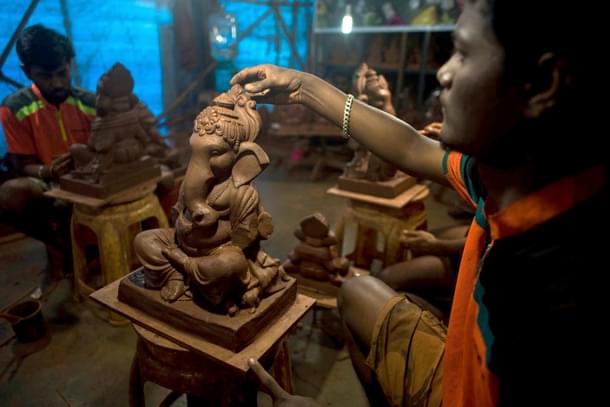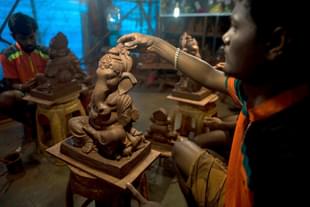Insta
For Eco-Friendly Ganesh Idols, Cow Dung Is Turning Out to Be The New Clay In Maharashtra
Swarajya Staff
Sep 01, 2018, 02:33 PM | Updated 02:33 PM IST
Save & read from anywhere!
Bookmark stories for easy access on any device or the Swarajya app.


The trend of using alternative material for making eco-friendly depictions of Lord Ganesh ahead of Ganesh Chaturthi, is witnessing a change. There is an increase in demand for idols made using cow dung, Sakal Times reported.
For making eco-friendly idols, which are gaining popularity, cow dung is mixed with clay — the main constituent. The idea is to arrive at depictions that are easy to mingle with the elements and do not harm the environment after visarjan — when the idol, traditionally, is submerged in water bodies.
According to the report, sheltering 100 cows, Go-Dham, a gaushala (cow shelter) run by Nitin Gotkule, in the IT hub of Hinjewadi, uses cows exclusively for dung and urine for making making Ganesh idols. Dung from the cow shelter is mixed with "curd, ghee and sadu mud", with an aim to include five elements to derive ‘panchatatva Ganpati’ — an idol made out of five elements. The idols made from dung in this cow shelter are sold in Pimpri, Chinchwad, Lonavla, Talegaon and Bengaluru.
On material added to the ingredients, Gotkule said, “According to the demand, we make idols, which are of 50 per cent clay and 50 per cent cow dung." Idols made of cow dung are not painted. For idols made of clay, he uses "natural dyes made from black plum (jamun), turmeric and saffron."
Gotkule is not alone to experiment with cow dung and other elements to churn out Ganesh idols. Prasad Sindagi, a chemical engineer, has picked up the art this year in Talegaon-Dabhade. He has employed 30 local women for idol making.
His idols use a bigger share of cow dung. He has replaced clay with "fertile soil". He says, "These idols are a combination of 70 per cent cow dung, 20 per cent of fertile soil, four per cent of alum and rest of panchatatva. We started making idols from March and around 2,000 idols have been made, which ranges from 1 to 2 feet in height."
Sindagi is shipping 140 and 50 idols to the United Kingdom and United States respectively, while 100 are sold in Pune and 350 in Mumbai.
Interestingly, Gotkule is training "framers and women from Nagpur, Sangli, Satara and Kolhapur to make Ganesh idols from cow dung and clay." This, perhaps, would give them extra income and keep an art flourishing and alive.





